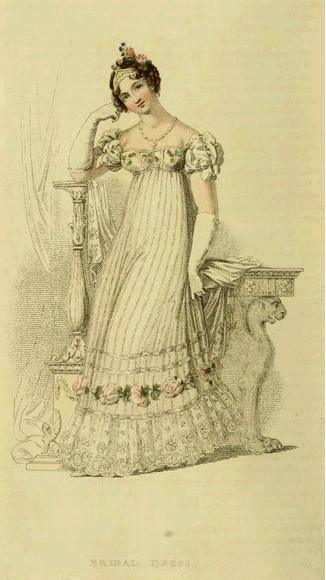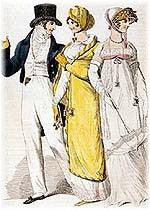
This Evening Ensemble and many other gowns can be seen on display at the Jane Austen Centre, which boasts a fine hands on collection of Gentlemen's, Ladies' and Children's wear.
The main over part of the gown is made from a length of Indian silk, shot in two shades of green, using the woven borders as part of the design. The undergown is plain cream silk decorated with pearl braid and a tuck. At this time, many enterprising traders went to India to make their fortunes, sending gifts of shawls and local fabrics to their female relatives at home. There are several examples in costume collections of dresses made from such items, with the cut of the gown being carefully adapted to take advantage of the borders, doubtless giving their makers quite a challenge so as not to waste a precious inch. The dress on display is based on an original in the collection at Snowshill Manor [NT] and a similar design was worn by Mrs Weston in the latest television adaptation of Emma, at the Crown Inn Ball.
The sleeves are interestingly detailed, with tulip-shaped oversleeves over the popular puffed shape; the sleeve band is decorated with gold cord and pearl braid.
Headdresses for the evening would range from a simple ribbon round the wearer's curls to an elaborate turban twisted from lengths of silk, decorated with brooches, cords and, of course, some imposing feathers. The older lady would wear a cap made of very fine lawn, often elaborately frilled and flounced.

Shawls or stoles completed the evening ensemble - often, Indian cashmere was the choice which was later copied by British manufacturers and endured as a fashion until the 1860s. The shape gradually evolved from rectangular to a large square; fabrics could be fine wool, silk, cotton or a mixture, often with colourful woven borders, usually in the Kashmir pine-cone design, in bright colours, which later became the pattern we know as Paisley - [because that town became the centre of the shawl weaving trade]. The stole on display is of fine silk georgette with green silk edging and gold fringe.
All sewing was done by hand at this time and there were only a few diagrammatic patterns available. Fashion magazines, such as La Belle Assemblee, Ackerman's Repository or the Lady's Magazine showed eager readers fashion plates of the very latest modes in London or Paris, and those ladies fortunate enough to be visiting centres of fashion, such as Bath, wrote letters home with detailed descriptions and sketches of what the fashion leaders were wearing. This information was then used to create their own interpretations of "the latest thing" for those at home. Newspapers, too, reported on current fashion; from the
London Recorder, 1806:
The dresses of ladies were in general white muslin, with a slight intermixture of lilac and peachblossom. The headdresses were either Grecian or Egyptian; ostrich feathers were generally worn; on the whole, the Drawing-room wore a much more brilliant aspect than usual.

Even gentlewomen often made their own gowns, and certainly, in households such as the Bennet's in Pride and Prejudice, the sisters would have made some of their own clothes. In every locality there were seamstresses, often called mantua-makers, who would make for those who could afford it and the ideal ladies' maid was able to make, repair and alter her mistress's clothes.
Costume researched, designed and constructed by Yvonne Roe, Gloucester. Special to the Jane Austen Centre, Bath.
Supplemental fashion plates, by permission from Cathy Decker, The Regency Fashion Page.
Enjoyed this article? Visit our giftshop and
escape into the world of Jane Austen for costumes, patterns and accessories.
 This Evening Ensemble and many other gowns can be seen on display at the Jane Austen Centre, which boasts a fine hands on collection of Gentlemen's, Ladies' and Children's wear.
The main over part of the gown is made from a length of Indian silk, shot in two shades of green, using the woven borders as part of the design. The undergown is plain cream silk decorated with pearl braid and a tuck. At this time, many enterprising traders went to India to make their fortunes, sending gifts of shawls and local fabrics to their female relatives at home. There are several examples in costume collections of dresses made from such items, with the cut of the gown being carefully adapted to take advantage of the borders, doubtless giving their makers quite a challenge so as not to waste a precious inch. The dress on display is based on an original in the collection at Snowshill Manor [NT] and a similar design was worn by Mrs Weston in the latest television adaptation of Emma, at the Crown Inn Ball.
The sleeves are interestingly detailed, with tulip-shaped oversleeves over the popular puffed shape; the sleeve band is decorated with gold cord and pearl braid.
Headdresses for the evening would range from a simple ribbon round the wearer's curls to an elaborate turban twisted from lengths of silk, decorated with brooches, cords and, of course, some imposing feathers. The older lady would wear a cap made of very fine lawn, often elaborately frilled and flounced.
This Evening Ensemble and many other gowns can be seen on display at the Jane Austen Centre, which boasts a fine hands on collection of Gentlemen's, Ladies' and Children's wear.
The main over part of the gown is made from a length of Indian silk, shot in two shades of green, using the woven borders as part of the design. The undergown is plain cream silk decorated with pearl braid and a tuck. At this time, many enterprising traders went to India to make their fortunes, sending gifts of shawls and local fabrics to their female relatives at home. There are several examples in costume collections of dresses made from such items, with the cut of the gown being carefully adapted to take advantage of the borders, doubtless giving their makers quite a challenge so as not to waste a precious inch. The dress on display is based on an original in the collection at Snowshill Manor [NT] and a similar design was worn by Mrs Weston in the latest television adaptation of Emma, at the Crown Inn Ball.
The sleeves are interestingly detailed, with tulip-shaped oversleeves over the popular puffed shape; the sleeve band is decorated with gold cord and pearl braid.
Headdresses for the evening would range from a simple ribbon round the wearer's curls to an elaborate turban twisted from lengths of silk, decorated with brooches, cords and, of course, some imposing feathers. The older lady would wear a cap made of very fine lawn, often elaborately frilled and flounced.
 Shawls or stoles completed the evening ensemble - often, Indian cashmere was the choice which was later copied by British manufacturers and endured as a fashion until the 1860s. The shape gradually evolved from rectangular to a large square; fabrics could be fine wool, silk, cotton or a mixture, often with colourful woven borders, usually in the Kashmir pine-cone design, in bright colours, which later became the pattern we know as Paisley - [because that town became the centre of the shawl weaving trade]. The stole on display is of fine silk georgette with green silk edging and gold fringe.
All sewing was done by hand at this time and there were only a few diagrammatic patterns available. Fashion magazines, such as La Belle Assemblee, Ackerman's Repository or the Lady's Magazine showed eager readers fashion plates of the very latest modes in London or Paris, and those ladies fortunate enough to be visiting centres of fashion, such as Bath, wrote letters home with detailed descriptions and sketches of what the fashion leaders were wearing. This information was then used to create their own interpretations of "the latest thing" for those at home. Newspapers, too, reported on current fashion; from the London Recorder, 1806: The dresses of ladies were in general white muslin, with a slight intermixture of lilac and peachblossom. The headdresses were either Grecian or Egyptian; ostrich feathers were generally worn; on the whole, the Drawing-room wore a much more brilliant aspect than usual.
Shawls or stoles completed the evening ensemble - often, Indian cashmere was the choice which was later copied by British manufacturers and endured as a fashion until the 1860s. The shape gradually evolved from rectangular to a large square; fabrics could be fine wool, silk, cotton or a mixture, often with colourful woven borders, usually in the Kashmir pine-cone design, in bright colours, which later became the pattern we know as Paisley - [because that town became the centre of the shawl weaving trade]. The stole on display is of fine silk georgette with green silk edging and gold fringe.
All sewing was done by hand at this time and there were only a few diagrammatic patterns available. Fashion magazines, such as La Belle Assemblee, Ackerman's Repository or the Lady's Magazine showed eager readers fashion plates of the very latest modes in London or Paris, and those ladies fortunate enough to be visiting centres of fashion, such as Bath, wrote letters home with detailed descriptions and sketches of what the fashion leaders were wearing. This information was then used to create their own interpretations of "the latest thing" for those at home. Newspapers, too, reported on current fashion; from the London Recorder, 1806: The dresses of ladies were in general white muslin, with a slight intermixture of lilac and peachblossom. The headdresses were either Grecian or Egyptian; ostrich feathers were generally worn; on the whole, the Drawing-room wore a much more brilliant aspect than usual.
 Even gentlewomen often made their own gowns, and certainly, in households such as the Bennet's in Pride and Prejudice, the sisters would have made some of their own clothes. In every locality there were seamstresses, often called mantua-makers, who would make for those who could afford it and the ideal ladies' maid was able to make, repair and alter her mistress's clothes.
Costume researched, designed and constructed by Yvonne Roe, Gloucester. Special to the Jane Austen Centre, Bath.
Supplemental fashion plates, by permission from Cathy Decker, The Regency Fashion Page.
Enjoyed this article? Visit our giftshop and escape into the world of Jane Austen for costumes, patterns and accessories.
Even gentlewomen often made their own gowns, and certainly, in households such as the Bennet's in Pride and Prejudice, the sisters would have made some of their own clothes. In every locality there were seamstresses, often called mantua-makers, who would make for those who could afford it and the ideal ladies' maid was able to make, repair and alter her mistress's clothes.
Costume researched, designed and constructed by Yvonne Roe, Gloucester. Special to the Jane Austen Centre, Bath.
Supplemental fashion plates, by permission from Cathy Decker, The Regency Fashion Page.
Enjoyed this article? Visit our giftshop and escape into the world of Jane Austen for costumes, patterns and accessories.


Leave a comment
This site is protected by hCaptcha and the hCaptcha Privacy Policy and Terms of Service apply.